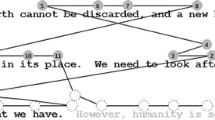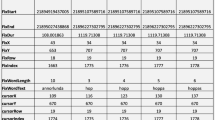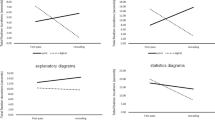Abstract
In this paper we explored text production differences in an expository text production task between writers who looked mainly at the keyboard and writers who looked mainly at the monitor. Eye-tracking technology and keystroke-logging were combined to systematically describe and define these two groups in respect of the complex interplay between text production and the reading of one’s own emerging text. Findings showed that monitor gazers typed significantly faster and were more productive writers. They also read their own text more, and they frequently read in parallel with writing. Analysis of fixation durations suggests that more cognitive processing is in use during reading in parallel with writing than during reading in pauses. Keyboard gazers used the left and right cursor keys significantly more. We suggest that this is because they revised their texts in a much more serial mode than monitor gazers. Finally, analysis of the characteristics of the final texts showed no differences between the groups.



Similar content being viewed by others
References
Alamargot, D., Dansac, C., Chesnet, D., & Fayol, M. (2007). Parallel processing before and after pauses: A combined analysis of graphomotor and eye movements during procedural text production. In M. Torrance, D. Galbraith, & L. van. Waes (Eds.), Writing and cognition: Research and applications (Studies in Writing, Vol. 20, pp. 13–29). Oxford: Elsevier.
Alvès, R. A., Castro, S. L., de Sousa, L., & Strömqvist, S. (2007). Influence of typing skill on pause-execution cycles in written composition. In M. Torrance, D. Galbraith, & L. van. Waes (Eds.), Writing and cognition: Research and applications (Studies in Writing, Vol. 20, pp. 55–65). Oxford, UK: Elsevier.
Andersson, B., Dahl, J., Holmqvist, K., Holsanova, J., Johansson, V., Karlsson, H., Strömqvist, S., Tufvesson, S., & Wengelin, Å. (2006). Combining keystroke logging with eye tracking. In L. Van Waes, M. Leijten, & C. Neuwirth (Eds.), Writing and digital media (Studies in Writing, Vol. 17. pp. 166–172). Oxford: Elsevier.
Baddeley, A. D., & Hitch, G. (1974). Working memory. In G. A. Bower (Ed.), The psychology of learning and motivation (Vol. 8, pp. 47–89). San Diego, CA: Academic Press.
Beers, S. F., Quinlan, T., & Harbaugh, A. G. (2009). Reading during writing and adolescent students’ writing competence: An eyetracking study. Reading and writing: An Interdisciplinary Journal (this issue).
Bereiter, C., & Scardamalia, M. (1987). The psychology of written composition. Hillsdale, NJ: Erlbaum.
Berman, R. A., & Verhoeven, L. (2002). Cross-linguistic perspectives on the development of text-production abilities: Speech and writing. Written Language and Literacy, 5, 1–44.
Bourdin, B., & Fayol, M. (1994). Is written language production more difficult than oral language production—a working-memory approach. International Journal of Psychology, 29(5), 591–620.
Fayol, M. (1999). From on-line management problems to strategies in written composition. In M. Torrance & G. Jeffery (Eds.), The cognitive demands of writing (Studies in writing, Vol. 3, pp. 13–24). Amsterdam: Amsterdam University Press.
Gentner, D. R., Larochelle, S., & Grudin, J. (1988). Lexical, sublexical, and peripheral effects in skilled typewriting. Cognitive Psychology, 20, 524–548.
Grabowski, J. (2008). The internal structure of university students’ keyboard skills. Journal of writing research, 1(1), 27–52.
Hayes, J. R., & Flower, L. (1980). Identifying the organisation of the writing process. In L. W. Gregg & E. R. Steinberg (Eds.), Cognitive processes in writing (pp. 3–30). Hillsdale, NJ: Lawrence Erlbaum.
Herrström, M. (1998). Djur lästest. Simrishamn: Ordfabriken.
Holmqvist, K., Johansson, V., Strömqvist, S., & Wengelin, Å. (2002). Studying reading and writing online. In S. Strömqvist (Ed.), The diversity of languages and language learning (pp. 103–123). Lund, Sweden: Lund University, Centre for Languages and Literature.
Hunt, K. (1970). Recent measures in syntactic development. In M. Lester (Ed.), Readings in applied transformation grammar (pp. 187–200). New York: Holt, Rinehart & Winston.
Inhoff, A. W., & Gordon, A. (1998). Eye movements and eye-hand coordination during typing. Current Directions in Psychological Science, 6(6), 153–157.
Inhoff, A. W., & Wang, J. W. (1992). The encoding of text, manual movement planning, and eye-hand coordination during copytyping. Journal of Experimental Psychology: Human Perception and Performance, 18, 437–448.
Johansson, M.-G. (1992). LS klassdiagnoser i läsning och skrivning för högstadiet och gymnasiet. Stockholm, Sweden: Psykologiförlaget.
Johansson, R., Johansson, V., Wengelin, Å., & Holmqvist, K. (2008). Reading during writing: Four groups of writers. Working Papers 53 (pp. 43–59). Lund, Sweden: Lund University, Department of Linguistics.
Kaufer, D. S., Hayes, J. R., & Flower, L. (1986). Composing written sentences. Research in the Teaching of English, 20(2), 121–140.
Kellogg, R. T. (1996). A model of working memory in writing. In C. M. Levy & S. Ransdell (Eds.), The science of writing: Theories, methods, individual differences and applications (pp. 57–71). Mahwah, NJ: Lawrence Erlbaum.
Kellogg, R. T. (2001). Competition for working memory among writing processes. American Journal of Psychology, 114(2), 175–191.
Kollmorgen, S., & Holmqvist, K. (2007). Automatically detecting reading in eye tracking data. Lund, Sweden: Lund University, Department of Cognitive Science.
Liversedge, S. P., & Findlay, J. M. (2000). Saccadic eye movements and cognition. Trends in Cognitive Sciences, 4(1), 6–14.
Logan, F. A. (1999). Errors in copy typewriting. Journal of Experimental Psychology: Human Perception and Performance, 25, 1760–1773.
Logan, G. D. (2003). Simon-type effects: Chronometric evidence for keypress schemata in typewriting. Journal of Experimental Psychology: Human Perception and Performance, 29, 741–757.
McCutchen, D., Covill, A., Hoyne, S. H., & Mildes, K. (1994). Individual differences in writing skill: Implications of translating fluency. Journal of Educational Psychology, 86, 256–266.
McKee, G., Malvern, D., & Richards, B. (2000). Measuring vocabulary diversity using dedicated software. Literary and Linguistic Computing, 15, 323–337.
O’Regan, J. K. (1992). Optimal viewing position in words and the strategy-tactics theory of eye movements in reading. In K. Rayner (Ed.), Eye movements and visual cognition: Scene perception and reading (pp. 333–354). New York: Springer.
Olive, T., & Kellogg, R. T. (2002). Concurrent activation of high- and low-level production processes in written composition. Memory and Cognition, 30(4), 594–600.
Olive, T., & Piolat, A. (2002). Suppressing visual feedback in written composition: Effects on processing demands and coordination of the writing processes. International Journal of Psychology, 37(4), 209–218.
Ransdell, S., & Levy, C. M. (1996). Working memory constraints on writing quality and fluency. In C. M. Levy & S. Ransdell (Eds.), The science of writing: Theories, methods, individual differences, and applications (pp. 93–105). Mahwah, NJ: Lawrence Erlbaum.
Rayner, K. (1998). Eye movements in reading and information processing: 20 years of research. Psychological Bulletin, 124(3), 372–422.
Reichle, E. D., Pollatsek, A., Fisher, D. L., & Rayner, K. (1998). Toward a model of eye movement control in reading. Psychological Review, 105, 125–157.
Rumelhart, D. E., & Norman, D. A. (1982). Simulating a skilled typist: A study of skilled cognitive-motor performance. Cognitive Science, 6, 1–36.
Starr, M. S., & Rayner, K. (2001). Eye movements during reading: Some current controversies. Trends in Cognitive Sciences, 5(4), 156–163.
Strömqvist, S., & Karlsson, H. (2001). ScriptLog for Windows—user’s manual. Technical Report. Lund University: Department of Linguistics; and University College of Stavanger: Centre for Reading Research.
Van Waes, L., Leijten, M., & Quinlan, T. (2009). Reading during sentence composing and error correction: A multilevel analysis of the influences of task complexity. Reading and writing: An Interdisciplinary Journal (this issue).
Wengelin, Å. (2006). Examining Pauses in Writing: Theory, Methods and Empirical Data. In K. Sullivan & E. Lindgren (Eds.), Computer key-stroke logging and writing (Studies in Writing, Vol. 18, pp. 107–130). Amsterdam: Elsevier.
Wengelin, Å. (2007). The word level focus in text production by adults with reading and writing difficulties. In M. Torrance, L. Van Waes, & D. Galbraith (Eds.), Writing and cognition research and applications (Studies in Writing, Vol. 20, pp. 67–82). Amsterdam: Elsevier.
Wengelin, Å., Torrance, M., Holmqvist, K., Simpson, S., Galbraith, D., Johansson, V., & Johansson, R. (2009). Combined eye-tracking and keystroke-logging methods for studying cognitive processes in text production. Behavior Research Methods, 41, 337–351.
Acknowledgments
This research was funded by the Swedish Research Council (Vetenskapsrådet 2004–2687). Thanks to Bodil Andersson, Jana Holsanova, Sofia Söderberg and Sylvia Tufvesson for data collection and important input on the design of the data collection as well as the analyses; to Johan Dahl and Henrik Karlsson for programming help; to Sepp Kollmorgen for developing the reading filter; and to Sven Strömqvist for being the driving force behind the technology development that made the data collection possible. Finally, thanks to anonymous reviewers for commenting on and thus improving the text, and to Johan Segerbäck for proof reading the text and improving our English.
Author information
Authors and Affiliations
Corresponding author
Rights and permissions
About this article
Cite this article
Johansson, R., Wengelin, Å., Johansson, V. et al. Looking at the keyboard or the monitor: relationship with text production processes. Read Writ 23, 835–851 (2010). https://doi.org/10.1007/s11145-009-9189-3
Received:
Accepted:
Published:
Issue Date:
DOI: https://doi.org/10.1007/s11145-009-9189-3




